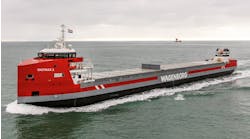Later this year and early in 2007, Bourbon Offshore will deliver two new platform supply vessels to BP Norge for deployment in the Norwegian southern North Sea. The vessels, under construction at Ulstein Verft’s shipyard complex in Ulsteinvik, are thought to be the first PSVs anywhere to meet the new `Clean Design’ class specifications - they are designed for oil recovery and standby rescue operations, as well as conventional bulk and cargo transfer tasks.
According to Bourbon Offshore’s Managing Director Christian Lefevre, the new designation is a step up from the established “Clean Class”, which applied to ships’ engines and waste disposal techniques.
“Clean Design”, he says, “is similar to what shipowners have been doing with tankers. It means that the vessel is double-hulled, with no dirty product on the outside of the hull, with stringent gas unloading conditions, advanced anti-pollution equipment, and catalyzers for the engine exhaust gases. In the case of our new PSVs, we have achieved a double-hull design with the tanks positioned in the center of the vessels to ensure there is no liquid fuel in contact with the hull skin.
“This configuration means you have to add a little bit more in steel weight, but there is no impact whatsoever on stability. You do lose, perhaps, a few tons of capacity.”
The 4,750-ton dwt, DP2 class PX Ulstein 105 vessels, theBourbon Mistral and Bourbon Monsoon, measure 88.8 m long, with a beam of 19 m, and a maximum draft of 6.5 m. Overall cargo deck area is 62.2 x 16 m. Both are equipped with diesel-electric engines outputting up to 6,320 kW of power, with a maximum transit speed of 16 knots (kt).
“BP was particularly interested in the vessels’ capability to maintain a high speed with low fuel consumption,” Lefevre says. The hull shape, in combination with the diesel-electric propulsion, will lead to fuel use at the following rate:
- 7 tons/day at 10 kt, carrying a 3,800 tons cargo, and
- 24 tons/day at 14.5 kt, carrying 3,800 tons cargo.
By the end of this year, Bourbon Offshore expects to operate a fleet of 190 offshore vessels, including anchor handlers, crew boats, and multi-purpose construction ships. Among its recent newbuilds is the 4,900-ton dwtBourbon Peridot, a diesel-electric maintenance and subsea construction PSV, also designed and produced by Ulstein.
This vessel was recently upgraded with a 100-ton crane, allowing it to install and remove jumpers and other subsea structures. It is currently on contract for Amerada Hess off Equatorial Guinea. Other Bourbon Offshore vessels have been installing jumpers and subsea wellheads on the deepwater Girassol field off Angola over the past two years.




